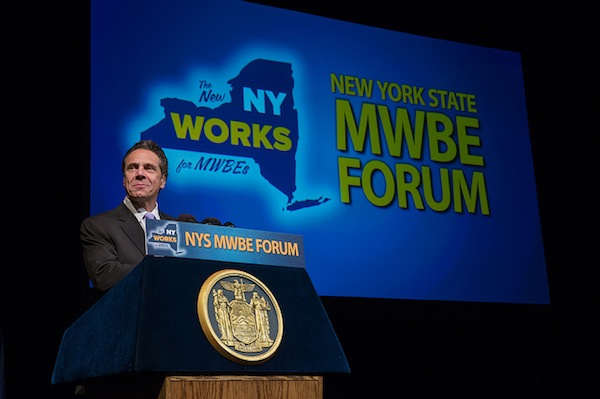
Photo by: Office of the Governor
Governor Andrew Cuomo recently announced at the fourth annual MWBE forum that his administration is dramatically increasing its goal for minority-and-women-owned enterprises (MWBE) state contracting utilization to 30 percent.
Gov. Andrew Cuomo recently announced the state’s blanket goal for awarding state contracts to minority- and women-owned companies was going up, from 20 to 30 percent.
The problem is nobody knows what’s going on under the blanket.
The new goal seems to be a belated attempt to address a disparity that was wider than the administration acknowledged in 2011. It’s based on dated data that won’t be refreshed until 2016. And the state’s goals gloss over important differences in how disadvantaged some groups are in certain industries, meaning help could be going where it’s least needed.
A moving target
In his first State of the State address in 2011, Cuomo announced a 20 percent goal for state contracts to MWBE firms at a time when the Empire State Development Corporation (ESDC) said only 10 percent of state contracts went to those firms. In 2013, Cuomo announced the state hit 21 percent. Then last week, he announced that 25.12 percent, or $1.96 billion, of state contracts were awarded to companies owned by women or minorities in fiscal year 2013-2014. He used that achievement to warrant increasing the state’s top-down goal of 20 percent to 30 percent.
To stand up to court scrutiny, governments have to back up their MWBE goals with disparity data showing there are minority- and women-owned companies available and capable of completing government contracts that aren’t getting the work.
When questioned about the legality of changing the goal without new data, the governor’s office said its goal was based on the the same data used to create the original 20 percent—a goal that apparently fell far short of the disparity it intended to address.
The last disparity study conducted in New York State was presented to Gov. David Paterson in 2010, with data from 2004 to 2008. In that study, the overall availability of minority- and women-owned firms capable of doing state work was determined to be 28.96 percent. This means the first goal, set in 2011, could have been 28.96 percent, or as the governor decided to do recently, rounded up to 30 percent.
When asked about changing this now, Deputy Secretary for Civil Rights Alphonso B. David wrote, “The governor’s previous 20 percent pronouncement was intended as a reasonable incremental step toward realizing the statewide availability found in the disparity study within the context of the state’s 10 percent utilization rate at that time. The disparity study data is the same.”
One problem with this is that for four years the state has been telling its agencies to hit a 20 percent goal when its own study recognized a 30 percent availability among minority- and women-owned firms. Agencies hitting that 20 percent years ago had no incentive to give more contracts to minority- or women-owned firms, even though the data was there to warrant the higher goal.
Divergence of disadvantages
Other than the obvious political motives for setting low goals, hitting them and then raising them, there are other problems with the state’s big 20 percent, and now 30 percent, goal.
The state’s 2010 study found that Asian-owned companies in construction-related professional services (engineering and architecture) do not have a significant enough disparity to even warrant being part of a goals program. The study also found Asian-owned construction and Hispanic-owned construction-related professional service firms were just above the disparity threshold established in numerous court cases. Yet those companies in those industries are counted toward the governor’s goal.
The governor’s office has not released a breakdown by industry and minority group since the goal was initiated in 2011, saying that not only is it not required to, but it doesn’t even “maintain such a metric,” according to an e-mail from David. The only breakdown the ESDC’s annual report includes is a split between minority-owned companies (48 percent) and women-owned companies (52 percent).
Without further breakdown, there is no way to know if the success the governor is touting is merely the result of more contracts going to companies that were not having trouble getting contracts in the first place. If that is case, then the program may have actually hurt companies in industries where racism and sexism persist.
The governor’s office argues it is not allowed to create goals within specify industries and for specific minority groups because the law, Article 15-A of the New York State Executive Law of 1988, does not permit it.
By contrast, New York City’s MWBE tracking does break down goals and performance by industry and ethnicity, gender or race—although the city’s performance on contracting goals is also far less impressive than the state’s.
Help wanted: new numbers
Another potential concerns about last week’s changed to the state’s MWBE goal is that it was based on data from 2004 to 2008—in other words, numbers from the boom and the recession, both of which have little to do with current economic conditions.
New data is on its way, but won’t arrive for another two years. In April, the ESDC released an RFP for a disparity study to be delivered to the governor by February 2016 (that RFP has not yet been awarded, according to David).
Rev. Jacques Andre DeGraff, a member of One Hundred Black Men of New York who is a well-known advocate for minority-owned companies and has even appeared in the governor’s press releases on MWBE announcements, said he wants more information.
“I’m concerned,” he said in a recent interview. “Who got the 20 percent and who is going to get the 30 percent?”
“I’d like to know what the breakdown is … because I believe that sunshine is the end of darkness.”








One thought on “Details Murky in Cuomo's Goal for Minority Contracts”
I would like to know what exactly is the state ordering? MWBE pencils? MWBE toilet tissue?